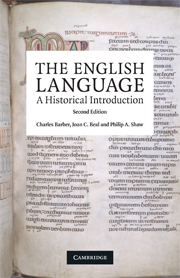Book contents
- Frontmatter
- Contents
- List of figures
- Preface to the second edition
- Preface to the first edition
- Map showing the counties of England
- 1 What is language?
- 2 The flux of language
- 3 The Indo-European languages
- 4 The Germanic languages
- 5 Old English
- 6 Norsemen and Normans
- 7 Middle English
- 8 Early Modern English
- 9 Late Modern English
- 10 English as a world language
- 11 English today and tomorrow
- Notes and suggestions for further reading
- Bibliography
- Index
11 - English today and tomorrow
- Frontmatter
- Contents
- List of figures
- Preface to the second edition
- Preface to the first edition
- Map showing the counties of England
- 1 What is language?
- 2 The flux of language
- 3 The Indo-European languages
- 4 The Germanic languages
- 5 Old English
- 6 Norsemen and Normans
- 7 Middle English
- 8 Early Modern English
- 9 Late Modern English
- 10 English as a world language
- 11 English today and tomorrow
- Notes and suggestions for further reading
- Bibliography
- Index
Summary
In the English language today we can see both centrifugal and centripetal tendencies. On the one hand, as we saw in the previous chapter, a range of ‘national’ varieties of English has emerged. In ‘inner-circle’ countries like Australia and New Zealand, RP was the prestigious accent in the first half of the twentieth century, but by the end of that century endogenous standards of pronunciation had taken over. On the other hand, processes of levelling and diffusion are respectively reducing the local diversity of dialects within the UK and spreading certain linguistic features over a wide area, in some cases throughout much of the UK and in others throughout the ‘inner circle’. This has been partly due to the great development of communications (aircraft, telegraph, telephone, the internet) and the rise of mass media (the popular press, the cinema, radio, television). The mutual influence between different national varieties of English shows itself especially in vocabulary. Many people are surprised to learn that some commonly used words are of American origin (chapter 10): words like cockroach, loafer, stevedore and tornado are so familiar that we do not think of them as Americanisms, and the same is true, or rapidly becoming true, of more recent importations like blurb, cagey, gimmick and rugged (in the sense of ‘robust’ as in ‘rugged individual’). American slang and colloquial words are particularly appealing, like hassle ‘quarrel, difficulty, fuss’, heist ‘hold-up, robbery’, hype ‘confidence-trick, swindle’, scam ‘ruse, swindle’ and to zap ‘attack suddenly, move quickly’.
- Type
- Chapter
- Information
- The English LanguageA Historical Introduction, pp. 265 - 281Publisher: Cambridge University PressPrint publication year: 2009

